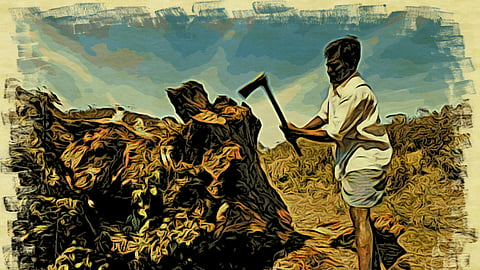- Commentary
- History Vignettes
- Notes on Culture
- Dispatches
- Podcasts
- Indian LanguagesIndian Languages
- Support

Maravarman Sundara Pandyan I holds the credit for singlehandedly reviving the shattered Pandyan power by wresting it from Kulothunga Chola III, who had been the Pandyan overlord for a long period. Sundara Pandya had not forgotten how Kulothunga’s unhinged armies had sacked the capital Madurai and burned down its famous coronation hall. When his time for revenge came, Sundara Pandya decimated the prosperous Chola strongholds of Thanjavur and Uraiyur and drove the old Chola monarch to exile. Next, Sundara Pandya raided Pon Amaravati (near modern-day Pudukottai) and occupied it. His crowning moment came when he took control of the ancient sacred temple town of Chidambaram. Inside the grand Chidambaram Temple where Nataraja had himself performed his Cosmic Tillai, Sundara Pandya got a Tulabharam done to commemorate his serial victories. All sorts of majestic titles followed. He was Kaliyugaraman (Sri Rama of the Kaliyuga), Adisayapandiyadevan (The Exceedingly Valorous Pandya Warrior), and Sonadugondan (Conqueror of the Chola Country).
Maravarman Sundara Pandya I was also a pious Shiva devotee and took enormous pride in the fact. He declared that his Kingly duties were his worship at the feet of Sundareshwara, husband of Meenakshi Devi, the Deity of Madurai. For centuries, the magnificent Meenakshi Temple was ferociously protected and generously endowed by such devout kings. They were devotees, not rulers of the Temple. In “independent” India, IAS officers and venal government officials operate with the gumption that they are “ruling” over Meenakshi Devi herself. The consequences are all too obvious, all too visible.
The other facet of Sundara Pandya’s Shiva Bhakti was his generosity. Every Monday, the auspicious day for performing Puja to Shiva, he would bestow gifts and special endowments to the temple and the devotees who were assembled there would get a firsthand taste of his profound magnanimity.
On one occasion, Sundara Pandya decided to perform a Mahapooja at the Meenakshi Sundareshwar Temple. It was a spectacular celebration akin to any great Hindu festival. The feast or Annadanam at the end of the Puja went on for days. Almost an endless supply of food flowed. Thousands of devotees ate the sanctified meal. Every man, woman, and child received a gift after the meal as part of the Tamboolam. Maravarman Sundara Pandya’s fame soared. He was extolled as the Karna of that era.
The fame went to his head. Sundara Pandya thought that he was the ideal Shiva Bhakta. He was disabused of that pride that very night. By Sundareshwara himself who appeared in his dream: “You fool! You really think you are my greatest devotee? What real devotion have you shown me so far? Tell me!”
Sundara Pandya was taken aback: “Swamin! As far as I know, I haven’t consciously done injustice to anybody. I have worshipped you with genuine devotion, you know that!”
“That is all fine. But you want to know what real Puja is? Go and meet my greatest devotee. He lives in the outskirts of your city. Learn from him.”
“Swamin, who is he? What does he do?”
“He is a woodcutter. He lives alone in a hut at the edge of the river. Go, seek him.”
Sundara Pandya woke up. His sleep was completely ruined. At dawn, he wore a disguise and noiselessly crept out of his palace. After walking for about half an hour, he reached the woodcutter’s modest hut and knocked. A minute later, the woodcutter opened the door. Sundara Pandya said he was travelling the whole country on a Yatra and narrated what he had heard in his dream. Then he asked him: “What special Puja do you perform? How did you become Sundareshwara’s greatest devotee? Please tell me your secret.”
The woodcutter was stunned when he heard this. In a tone of disbelief, he said: “Ayya, you must have mistaken me for someone else. I am a poor woodcutter. If you had come even half an hour later, you wouldn’t have found me at home.”
Sundara Pandya said, “That’s okay, but tell me how do you worship Shiva? At least tell me how you spend your day.”
The woodcutter said, “At daybreak, I go into the forest, chop some wood and bring it to the market when the shops open. Once everything is sold, I earn eight Annas. Of this, four Annas are enough to fill my stomach. I give one Anna to beggars and the needy. I save the remaining three Annas for the Monday Puja. On Monday, I give the three Annas to the temple and they prepare rice Payasam and offer it to Sundareshwara. This is the only worship I know. You see, even I want to, I cannot worship him the whole day because I have to earn my livelihood. And so, each time I cut the wood and do other routine work to carry on my life, I simply take his name in lieu of performing the Puja in the proper method. That is all.”
Sundara Pandya said nothing for a long time. Then he looked at the ground once, bowed down his head, did Namaskaram to the woodcutter and then prostrated before him. After this, he turned his back and left the place without a word.
All those grand titles, all that profuse praise, and his fabled generosity, his daanam....all of it suddenly felt meaningless and empty. Then the thought struck him: his favourite deity, Sundareshwara was himself a beggar who lived in a cemetery.
The Dharma Dispatch is now available on Telegram! For original and insightful narratives on Indian Culture and History, subscribe to us on Telegram.
